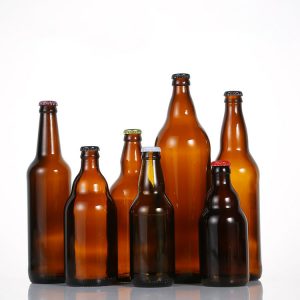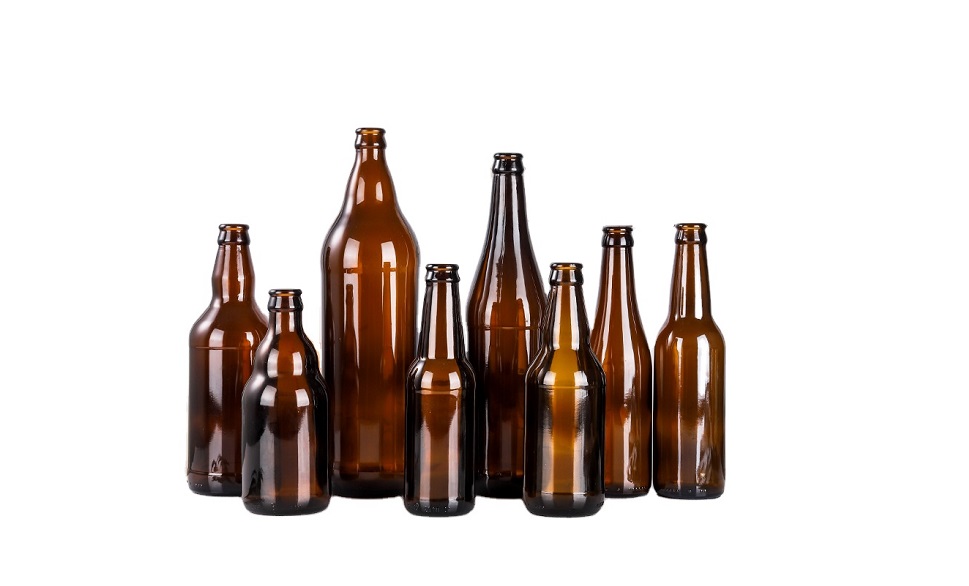Choosing the right beer bottle is more than selecting a capacity. Bottle size, color, neck finish and label design directly affect beer stability, brand positioning and how consumers perceive your product on the shelf. In this guide, we explain the common beer bottle sizes, how to choose the right color, and what to consider when planning labels and printing.

1. Common Beer Bottle Sizes
Beer bottle sizes vary by region, but several formats have become international standards. Below are the most commonly used sizes for retail, horeca and craft beer.
1.1 International Standard Sizes
-
12 oz / 355 ml – Widely used in the US and Canada for standard longneck bottles.
-
330 ml / 11.2 oz – Popular in Europe and many global markets; common for craft beer and premium lines.
-
500 ml / 16.9 oz – Traditional for many European beers, ales and lagers.
-
640–650 ml / 22 oz – “Bomber” style bottles for sharing or limited editions.
-
750 ml – Wine-style premium format used for specialty beers and higher-end craft products.
-
1 L & 2 L – Common for growlers, taproom to-go beer, horeca service and refill concepts.
1.2 Practical Range for Private Labels and Importers
From a manufacturing and export perspective, brands usually focus on these key families:
-
250–330 ml for single-serve beer and soda
-
330–500 ml for retail shelves
-
500–640 ml for restaurants and bars
-
1–2 L swing-top or growler formats for taprooms and premium applications
Choosing 2–3 core sizes that match your channels (retail + horeca + direct sales) often works best.
2. Choosing Beer Bottle Size by Sales Channel
2.1 Supermarkets and Retail Stores
Retail buyers prefer familiar sizes:
-
330 ml (Europe & global markets)
-
355 ml (North America)
-
500 ml (UK and specialty beers)
A practical setup is:
-
A core 330/355 ml bottle for your main line
-
A 500 ml bottle for premium or traditional variants
2.2 Bars, Restaurants and Hotels (Horeca)
For horeca, larger bottles work well:
-
500 ml, 640 ml, 1 L
-
Swing-top bottles for table service
-
Growlers for refill and house beer
2.3 Taprooms and Direct Sales
Taprooms often prefer:
-
1 L or 2 L swing-top bottles
-
Growlers for refillable concepts
-
Heavier bottles for premium feel and repeat use
3. Beer Bottle Color: Amber, Clear, Black and More
Color affects how well the beer is protected from light.
3.1 Amber (Brown) Beer Bottles
Amber glass blocks harmful UV and visible light, helping prevent “lightstruck” or “skunky” flavours. It is the safest and most widely used choice for hop-forward beers and long-term storage.
3.2 Clear (Flint) Beer Bottles
Clear bottles are used when:
-
You want to showcase the drink color
-
Beers are stored indoors away from direct sunlight
-
Drinks are non-beer products (sodas, RTDs, flavored beverages)
Clear glass works best with controlled logistics or non-light-sensitive formulations.
3.3 Green, Black and Specialty Colors
-
Green bottles offer medium light protection and a traditional European look.
-
Black bottles provide excellent protection and a premium, minimalist aesthetic.
-
Frosted and sprayed finishes enhance branding for limited editions or craft lines.
For export or supermarket environments, amber is usually the most reliable.
4. Neck Finish, Caps and Closures
4.1 Crown Caps (26 mm)
The majority of beer bottles use 26 mm crown caps. They are compatible with automatic cappers and widely available.
Key considerations:
-
Check compatibility with your capping machine
-
Ensure consistent neck finish dimensions
-
Choose oxygen-scavenging liners when needed
4.2 Swing-Top Closures
Swing-top bottles are ideal for:
-
Craft beer and farmhouse styles
-
Horeca refill programs
-
Taproom takeaway and growlers
They allow resealing and create a premium, traditional appearance.
5. Labeling, Printing and Branding
5.1 Label Types
-
Self-adhesive labels – ideal for flexible and seasonal products
-
Screen printing – permanent branding directly on the glass
-
Decals and hot stamping – metallics and premium effects
-
Spraying and frosting – matte or colored full-body finishes
5.2 Label Panel and Printable Area
Each bottle shape has a defined label panel. Request a technical drawing for accurate label dimensions, including:
-
Label panel height
-
Maximum width
-
Areas with embossing that may affect application
5.3 Compliance for Export Markets
Different regions require specific:
-
Warning labels
-
ABV formats
-
Deposit symbols
-
Multilingual text
Choosing a bottle with enough label space ensures compliance without compromising branding.
6. How to Choose the Right Beer Bottle Setup
Follow these steps when planning or upgrading your beer packaging:
-
Define sales channels (retail, horeca, taproom).
-
Select 1–3 core sizes that cover all channels efficiently.
-
Choose a color based on product stability and brand style.
-
Match the closure system to your filling line.
-
Confirm label dimensions with technical drawings.
A good glass supplier can help streamline these decisions and propose compatible bottle families with shared closures and packing options.
7. How We Can Support Your Beer Bottle Project
We supply beer bottles for:
-
Craft breweries
-
Soda & flavored drink brands
-
Importers & distributors
-
Horeca chains
Tell us your filling volume, target market, preferred colors, closures and annual quantities. We will recommend bottles, share technical drawings and prepare a quotation. You can also request mixed sizes in one container to test new markets.
For assistance, contact:
[email protected]
WhatsApp: +86-13776588366
Customization
Beer bottles are sold in one of three categories: stock, semi-custom or custom. Each category has advantages, and they are often strategically used together as a packaging solution that evolves with needs of the brewery.
Stock
Stock (also known as “standard”) bottles are the most convenient to specify and use. These fast-from-stock options can often be ordered in volume sizes of a pallet at a time. Stock bottles can be ordered directly from various manufacturers or distributors, who break volumes down to even smaller sizes. Stock bottles are available in a wide variety of styles and capacity sizes. However, your ability to differentiate the bottle through glass characteristics themselves will be limited with stock bottles.
Semi-custom
Semi-custom bottles were developed specifically to overcome this limitation. This category begins as a stock option and then adds brand iconography to the bottle profile with in-molded glass decoration.
Typically applied on the bottle’s shoulder, virtually any signature element can be embossed on the bottle; type, logos or texture or slogans are added by leveraging the advantages of glass packaging mold production.
Many breweries who begin with a stock bottle can easily move over to a semi-custom bottle because the critical bottle dimensions remain the same. Semi-custom bottles are a fast way for brands to create unique elements in their bottle profile.
The recently launched O-I : expressions relife has just made the access to semi-custom bottles easier and faster, while broadening the possibilities of customization that can be achieved through digitally printed, transparent or colored texture and embossing.
Custom beer bottles
Some of the most exciting bottles on the retail shelf are those that break with the conventions of a stock or semi-custom bottle profile. Full custom bottles have the advantage of creating an optimized bottle shape that is immediately recognizable. These custom shapes can further be made identifiable with in-molded brand names, iconography and textures.
Many brewers choose to work with a design agency or directly with the beer bottle manufacturers design team to create a bottle that is entirely custom to their brand. These one-of-a-kind bottles can come in a variety of shapes, sizes, colors and capacities and open the door to endless options for decoration, embossment and label panels. The tradeoffs to custom bottles are private mold costs, longer speed to market and bottle production scheduling and availability. Yet, custom bottles provide the greatest opportunity to create an iconic package with high brand equity.
Picking the correct bottle for your beer requires careful consideration of several packaging design elements. You must successfully choose how you will bring together various packaging components from size and shape to color and decoration to create a successful and compelling brand presence. You need the right product and packaging with the right positioning and the right market timing to be successful, and glass packaging offers a number of advantages to help you achieve success.


